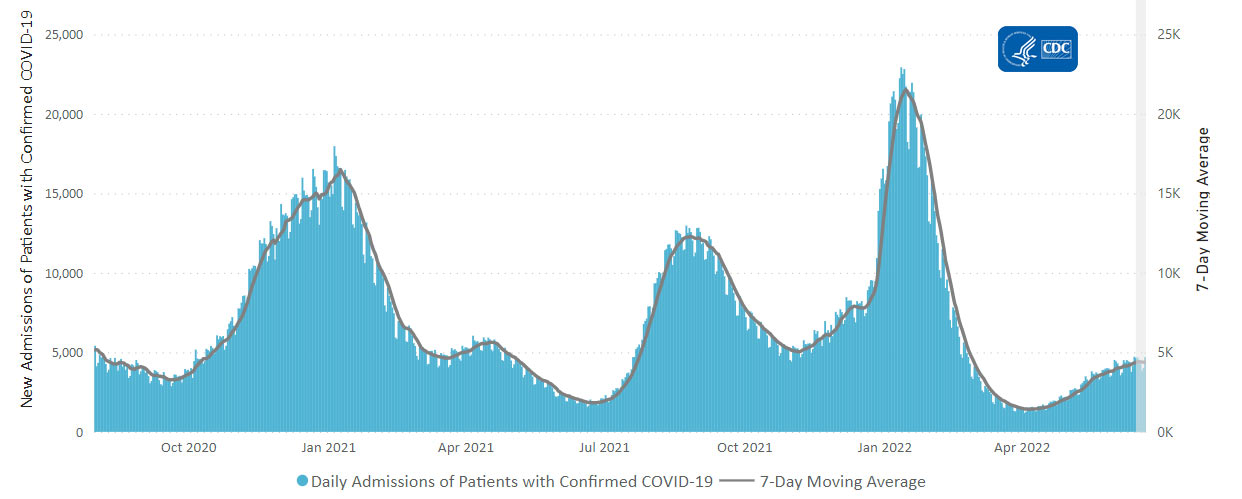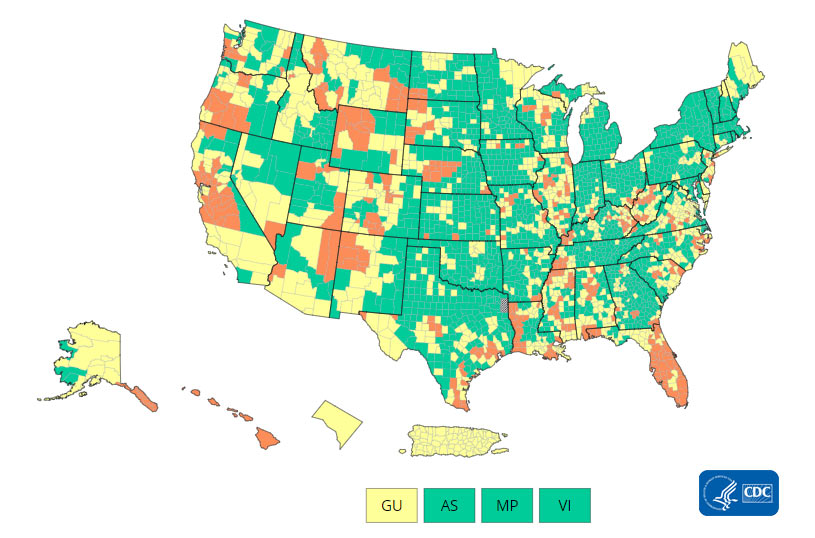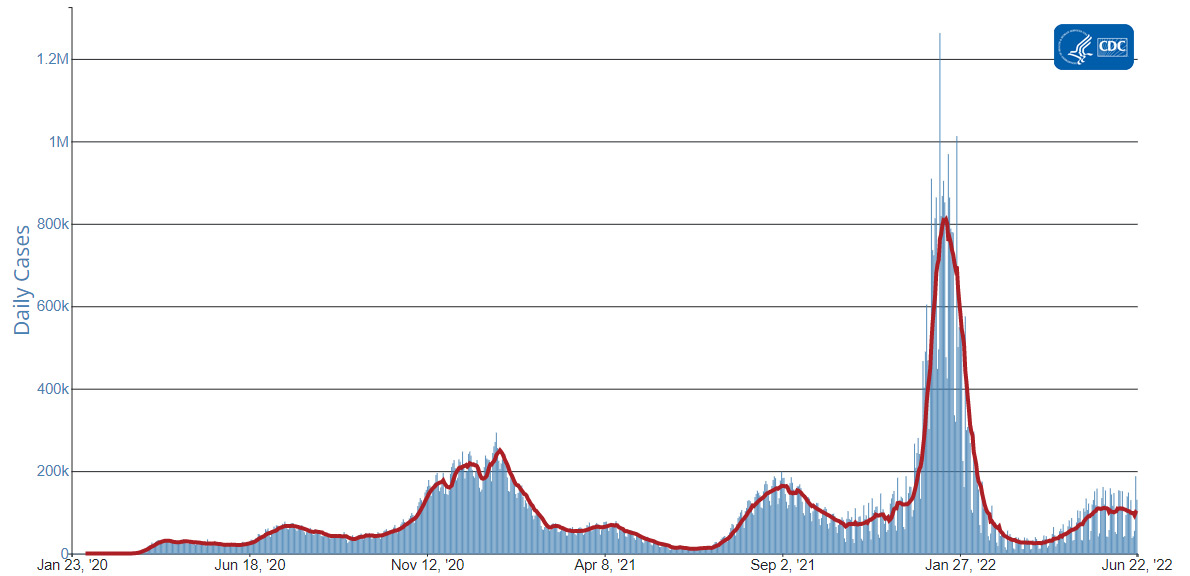Recommendations for Fully Vaccinated People
COVID-19 Homepage
The Wait is Over
Interpretive Summary for June 24, 2022

The Wait is Over
It’s the moment so many parents have been waiting for: COVID-19 vaccines are now recommended for children ages 6 months and older. This means that nearly 20 million more children can now be protected against COVID-19. Vaccination provides a critical opportunity to prevent serious illness, giving families with young children more options to participate in childcare, school, and other activities while protecting themselves and others through vaccination.
Both the Moderna and Pfizer-BioNTech COVID-19 vaccines have been approved for use in children ages 6 months through 5 years. The Moderna vaccine will be a two-dose primary series, and the Pfizer-BioNTech vaccine will be a three-dose primary series. After vaccination, children could have some mild and temporary side effects like those seen with other routine childhood vaccines.
CDC recommends that everyone ages 6 months and older get vaccinated, including children who have already had COVID-19. Both vaccines are safe and proven to protect children against serious illness from COVID-19. These vaccines have undergone—and will continue to undergo—the most intensive safety monitoring in U.S. history. Thousands of children participated in robust clinical trials to evaluate the safety of the vaccines and how well they work.
Vaccination provides the best defense against serious outcomes related to COVID-19. To find COVID-19 vaccines for children, visit vaccines.gov.
Note to parents and caregivers: You can register your child for v-safe to share how they’re feeling after vaccination. V-safe uses confidential text messaging and web surveys to provide personalized health check-ins following COVID-19 vaccination.
- A new chart showing COVID-19 vaccination primary series completion, booster dose eligibility, and booster dose receipt by age in the United States was added to the top of COVID Data Tracker’s COVID-19 Vaccinations in the United States tab.
- Dispensing of Oral Antiviral Drugs for Treatment of COVID-19 by Zip Code–Level Social Vulnerability — United States, December 23, 2021–May 21, 2022
- Hospitalization and Emergency Department Encounters for COVID-19 After Paxlovid Treatment — California, December 2021–May 2022
- COVID-19 Cases and Hospitalizations Among Medicare Beneficiaries With and Without Disabilities — United States, January 1, 2020–November 20, 2021
- Notes from the Field: COVID-19–Associated Mortality Risk Among Long-Term Care Facility Residents and Community-Dwelling Adults Aged ≥65 Years — Illinois, December 2020 and January 2022
- Notes from the Field: Diagnosis and Investigation of Pneumonic Plague During a Respiratory Disease Pandemic — Wyoming, 2021
- COVID-19 Vaccination Coverage, by Race and Ethnicity — National Immunization Survey Adult COVID Module, United States, December 2020–November 2021
COVID-19 Community Levels
As of June 23, 2022, there are 391 (12.1%) counties, districts, or territories with a high COVID-19 Community Level, 996 (30.9%) counties with a medium Community Level, and 1,830 (56.8%) counties with a low Community Level. This represents an increase (+1.9 percentage points) in the number of high-level counties, a slight increase (+1.6 percentage points) in the number of medium-level counties, and a corresponding decrease (−3.6 percentage points) in the number of low-level counties. 51 jurisdictions* had high- or medium-level counties this week. Rhode Island is the only jurisdiction to have all counties at low Community Level.
To check your COVID-19 Community Level, visit COVID Data Tracker. To learn which prevention measures are recommended based on your COVID-19 Community Level, visit COVID-19 Community Level and COVID-19 Prevention.
*There are 52 jurisdictions in the United States: the 50 states, the District of Columbia, and Puerto Rico.
Reported Cases
As of June 22, 2022, the current 7-day moving average of daily new cases (97,430) decreased 5.6% compared with the previous 7-day moving average (103,175). A total of 86,512,787 COVID-19 cases have been reported in the United States as of June 22, 2022.
CDC Nowcast projections* for the week ending June 18, 2022, estimate that the combined national proportion of lineages designated as Omicron will continue to be 100%. There are several lineages of Omicron, and within each are multiple sublineages.
The predominant Omicron lineage in the United States is BA.2.12.1. The national proportion is projected to be 56.0% (95% PI 51.4-60.5%). CDC has been monitoring increased numbers of the Omicron lineages BA.4 and BA.5. Previously, BA.4 and BA.5 were grouped with their parent lineage, BA.1.1.529, because the sublineages were circulating below 1%. BA.5 is now projected to be 23.5% (95% PI 20.3-27.0%) and BA.4 is projected to be 11.4% (95% PI 8.8-14.5%). See COVID DataTracker for current data.
88,056,795
Total Cases Reported
88,056,795
Total Cases Reported
106,549
Current 7-Day Average**
106,549
Current 7-Day Average**
110,875
Prior 7-Day Average
110,875
Prior 7-Day Average
-3.9%
Change in 7-Day Average since Prior Week
-3.9%
Change in 7-Day Average since Prior Week
*The median time from specimen collection to sequence data reporting is about 3 weeks. As a result, weighted estimates for the most recent few weeks may be unstable or unavailable. CDC’s Nowcast is a data projection tool that helps fill this gap by generating timely estimates of variant proportions for variants that are circulating in the United States. View Nowcast estimates on CDC’s COVID Data Tracker website on the Variant Proportions page.
**Historical cases are excluded from daily new cases and 7-day average calculations until they are incorporated into the dataset for the applicable date. Of 533,666 historical cases reported retroactively, 3 were reported in the current week and none were reported in the prior week.
Vaccinations
The U.S. COVID-19 Vaccination Program began December 14, 2020. As of June 22, 2022, 592.3 million vaccine doses have been administered in the United States. Overall, about 259.2 million people, or 78.1% of the total U.S. population, have received at least one dose of vaccine. About 221.9 million people, or 66.8% of the total U.S. population, have been fully vaccinated.* Of those fully vaccinated, about 104.7 million people have received a booster dose,** but 48.9% of the total booster-eligible population has not yet received a booster dose. As of June 21, 2022, the 7-day average number of administered vaccine doses reported (by date of CDC report) to CDC per day was 154,906, a 34.7% decrease from the previous week.
CDC’s COVID Data Tracker displays vaccination trends by age group, race/ethnicity, and urban/rural status. To see trends by age group and race/ethnicity, visit the Vaccination Demographic Trends tab. To see trends by urban/rural status, visit the COVID-19 Vaccination Equity tab.
597,655,035
Vaccine Doses Administered
597,655,035
Vaccine Doses Administered
260,327,743
People who received at least one dose
260,327,743
People who received at least one dose
222,455,652
People who are fully vaccinated*
222,455,652
People who are fully vaccinated*
78.4%
Percentage of the U.S. population that has received at least one dose
78.4%
Percentage of the U.S. population that has received at least one dose
67.0%
Percentage of the U.S. population that has been fully vaccinated*
67.0%
Percentage of the U.S. population that has been fully vaccinated*
+0.1
Percentage point increase from last week
+0.1
Percentage point increase from last week
+0.1
Percentage point change from last week
+0.1
Percentage point change from last week
*Represents the number of people who have received the second dose in a two-dose COVID-19 vaccine series (such as the Pfizer-BioNTech or Moderna vaccines) or one dose of the single-shot Johnson & Johnson’s Janssen vaccine.
**Represents the number of people who are fully vaccinated and have received another dose of COVID-19 vaccine since August 13, 2021. This includes people who received their first additional dose or booster dose.
Hospitalizations
New Hospital Admissions
The current 7-day daily average for June 15–21, 2022, was 4,375. This is a 1.0% increase from the prior 7-day average (4,329) from June 8–14, 2022.
4,906,251
Total New Admissions
4,906,251
Total New Admissions
5,080
Current 7-Day Average
5,080
Current 7-Day Average
4,930
Prior 7-Day Average
4,930
Prior 7-Day Average
+3.1%
Change in 7-Day Average
+3.1%
Change in 7-Day Average
The start of consistent reporting of hospital admissions data was August 1, 2020.
Daily Trends in Number of New COVID-19 Hospital Admissions in the United States

New admissions are pulled from a 10 am EDT snapshot of the HHS Unified Hospital Data – Analytic Dataset. Due to potential reporting delays, data from the most recent 7 days, as noted in the figure above with the grey bar, should be interpreted with caution. Small shifts in historic data may also occur due to changes in the Centers for Medicare & Medicaid Services (CMS) Provider of Services file, which is used to identify the cohort of included hospitals.
COVID-NET: Hospitalization Rates by Vaccination Status in Adults Ages ≥50 Years
CDC’s Coronavirus Disease 2019-Associated Hospitalization Surveillance Network (COVID-NET) shows that May 2022 rates of COVID-19-associated hospitalizations were higher in unvaccinated adults compared to adults who received a primary vaccination series plus a booster or additional dose of COVID-19 vaccine. Among adults ages 50–64 years, the rate was 3.4 times higher. Among adults ages 65 years and older, the rate was 3.8 times higher.
Rates of COVID-19-Associated Hospitalizations among Adults Ages ≥50 Years

The Coronavirus Disease 2019 (COVID-19)-Associated Hospitalization Surveillance Network (COVID-NET) is an additional source for hospitalization data collected through a network of more than 250 acute-care hospitals in 14 states (representing ~10% of the U.S. population). Detailed data on patient demographics, including race/ethnicity, underlying medical conditions, medical interventions, and clinical outcomes, are collected using a standardized case reporting form.
Deaths
The current 7-day moving average of new deaths (255) has decreased 10.4% compared with the previous 7-day moving average (285). As of June 22, 2022, a total of 1,010,089 COVID-19 deaths have been reported in the United States.
1,015,070
Total Deaths Reported
1,015,070
Total Deaths Reported
273
Current 7-Day Average*
273
Current 7-Day Average*
345
Prior 7-Day Average
345
Prior 7-Day Average
-20.9%
Change in 7-Day Average Since Prior Week
-20.9%
Change in 7-Day Average Since Prior Week
*Historical deaths are excluded from the daily new deaths and 7-day average calculations until they are incorporated into the dataset by their applicable date. Of 21,715 historical deaths reported retroactively, none were reported in the current week; and none were reported in the prior week.
Daily Trends in Number of COVID-19 Deaths in the United States Reported to CDC

7-Day moving average
 More Death Data
More Death DataTesting
The percentage of COVID-19 NAATs (nucleic acid amplification tests)* that are positive (percent positivity) is increasing in comparison to the previous week. The 7-day average of percent positivity from NAATs is now 13.6%. The 7-day average number of tests reported for June 10–16, 2022, was 544,429, down 22.6% from 703,169 for the prior 7 days.
916,128,298
Total Tests Reported
916,128,298
Total Tests Reported
414,614
7-Day Average Tests Reported
414,614
7-Day Average Tests Reported
17.5%
7-Day Average % Positivity
17.5%
7-Day Average % Positivity
15.4%
Previous 7-Day Average % Positivity
15.4%
Previous 7-Day Average % Positivity
+2.12
Percentage point change in 7-Day Average % Positivity since Prior Week
+2.12
Percentage point change in 7-Day Average % Positivity since Prior Week
*Test for SARS-CoV-2, the virus that causes COVID-19
Wastewater Surveillance
COVID Data Tracker’s Wastewater Surveillance tab tracks levels, changes, and detections of SARS-CoV-2* viral RNA in wastewater at over 1,000 testing sites across the country.
Currently, most of the country is reporting moderate to high SARS-CoV-2 levels in wastewater. Around 35% of sites are currently seeing some of the highest levels for those sites since December 1, 2021. Additionally, more than half of all sites reporting wastewater data are experiencing a decrease in SARS-CoV-2 levels, but about 41% of sites are reporting an increase in SARS-CoV-2 levels in wastewater. It’s important to note that even a small increase when levels are low can appear like a dramatic increase in the percent change.
For more information on how to use wastewater data visit CDC’s website.
*The virus that causes COVID-19
SARS-CoV-2 Levels in Wastewater by Site


0% means levels are the lowest they have been at the site; 100% means levels are the highest they have been at the site.





